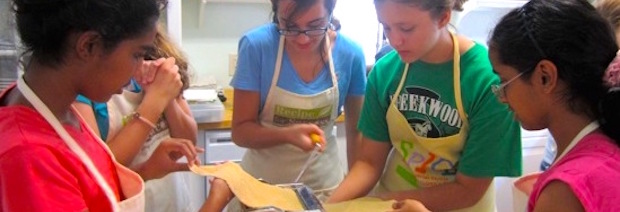We can make kids healthy
By GRACIE CAVNAR
HOUSTON CHRONICLE
Feb. 20, 2010, 7:37PM
First lady Michelle Obama recently announced her sweeping national initiative to combat childhood obesity. For the first time since this epidemic emerged, a comprehensive federal effort will coordinate with nonprofit organizations and the private sector to address the broad spectrum of contributing factors to obesity that together threaten generations of Americans with chronic disease and early death.
It's not a moment too soon. Already Texans are among the hardest hit by this phenomenon: In 2007, 66 percent of our adults and 32 percent of our high school students were clinically obese or severely overweight and at risk, and it's costing us a fortune. Obese children have a much higher risk of type 2 diabetes, hypertension, heart disease, liver disease, kidney failure and cancer. These diseases will strike them early, keep them out of the workplace and kill them young. Unhealthy eating is also taking a huge scholastic toll. Studies link diets high in refined sugar and saturated and trans fats to poor academics as nutrient-starved brains fail to operate effectively. The cause of this alarming spike in obesity is a complex web of changes that have taken place in our culture over the past 20 years.
Thanks to an early start on the front lines, Houston is now in an excellent position to emerge as a national leader and role model in the battle of the bulge. After an extensive study on obesity in 2003, St. Luke's Episcopal Health Charities concluded that an effective solution requires a multipronged approach of reforms at every government level along with the support of our entire community. We swung into action. In 2005, Texas was among the first states to ban vending machines from elementary schools. The mayor established the Houston Wellness Association in 2006 to advance community health. City Hall also paved the way for fresh-food production, farmers markets and grocery stores in neighborhoods that lack critical access, and improved parks, streetlights and sidewalks so children could walk to school and play outside. Recent completion of upgrades to their food-service facility has enabled Aramark/HISD to affordably meet new nutritional guidelines for school lunches. The Healthy Kids, Healthy Schools initiative mobilized parents and teachers to get involved in establishing healthier environments across multiple school districts. Partnerships like CAN DO (Children And Neighbors Defeat Obesity) facilitate far-reaching cooperation to change habits in neighborhoods using multiple entities to weave exercise and nutrition education opportunities together with enhanced food availability.
Many Houston programs serve as national models for transformation, but there is still much to do before we solve this problem once and for all. Recipe for Success Foundation, or RFS -- by working with the city, Houston ISD, every willing collaborator and 58 of our town's finest chefs -- has grown into the largest nutrition education initiative of its kind in the country. Reaching 3,000 Houston children every month and planning national expansion to meet increased demands, the successful RFS Seed-to-Plate Nutrition Education program gives children hands-on learning opportunities that empower them to create their own healthy meals and snacks. It is critical to educate a new kind of food consumer who integrates a nutritious diet into his or her normal lifestyle, rather than isolating the concept of healthy eating as an anomaly relegated to weight loss activity. RFS focuses on elementary students -- increasing their consumption of fresh fruits and vegetables and lowering their resistance to trying new foods -- because research says weight patterns and food attitudes are set for life by age 11. Their experiential classes in school gardens and kitchen classrooms are making a marked difference, with parents reporting that their kids are now cooking at home and turning away from foods they have learned are unhealthy.
Still, it's parents who have the most influence over a child's food attitudes, diet and healthy habits. It's an uphill battle in a perfect storm that makes the job harder than ever: Less unstructured playtime for the kids; a more sedentary lifestyle for all of us; billions of dollars of advertising directed at impressionable young people to promote junk food of every stripe; and a swirling family and work schedule that gets in the way of eating meals together.
Americans make as many as 4,000 eating decisions every single year of their lives, so there are many opportunities for modification. As consumers, we have extraordinary power and we must seize it. Will you join the fight?
Be proactive
• • Don't assume that food products available for sale are automatically safe for you and your family to eat. Ask questions.
• • Read food labels and understand what they mean so you can make better decisions.
• • Learn what age-appropriate nutrition your child needs for healthy body and brain development.
• • Get involved at school: Stop by for lunch; insist that your school offer appealing, healthy choices that don't have to compete with unhealthy a la carte items; if you are unhappy with the menus, send a healthy lunch from home; make sure vending machines have disappeared from your school and that clubs don't raise funds with candy and junk food.
Be a good role model
These are small steps that you can take to slowly change your home environment.
• • Provide only healthy choices at home. Research shows that children eat what's there, whether it's an apple or a bag of chips.
• • Don't give up on introducing healthy foods. It takes up to 15 offers before a child will accept something new.
• • Limit sodas and sugary drinks -- even too much fruit juice is not good -- and promote the consumption of water. Our kids drink about five sodas every day. That's 7,000 empty calories and two extra pounds a week.
• • Introduce your children to fresh whole foods by including them in shopping, gardening and cooking. Children willingly eat new healthy foods that they have helped grow, plan or prepare.
• • Train by example: Model and teach healthy food choices, frequency and portion sizes. Portion size directly affects how much we eat. Don't supersize! A healthy serving is the size of a pack of cards. Eat together at home more often.
• • Exercise as a family -- walking, swimming, biking, dancing, games -- and get the kids involved in team sports.
• • Limit TV viewing and recreational screen time to less than two hours daily.
Raise an aware consumer
Children are very susceptible to slick marketing campaigns but can't yet make an informed decision about what is true and what isn't.
• • Educate your children about the difference between advertising promotions and facts.
• • Tutor your family to read nutrition labels and understand what they mean.
• • Set limits for your kids. Treats in moderation are OK, just not instead of healthy meals.
Be the change
Don't think you have to do everything at once. Small changes over time will make a big difference in your life and that of the next generation. Now, turn off the TV, cook dinner with your kids, and then take the family for a walk. Come on, Houston! Let's show the rest of the country how it's done.
Cavnar is founder of the Recipe for Success Foundation.
http://www.chron.com/disp/story.mpl/editorial/outlook/6877416.html
By GRACIE CAVNAR
HOUSTON CHRONICLE
Feb. 20, 2010, 7:37PM
First lady Michelle Obama recently announced her sweeping national initiative to combat childhood obesity. For the first time since this epidemic emerged, a comprehensive federal effort will coordinate with nonprofit organizations and the private sector to address the broad spectrum of contributing factors to obesity that together threaten generations of Americans with chronic disease and early death.
It's not a moment too soon. Already Texans are among the hardest hit by this phenomenon: In 2007, 66 percent of our adults and 32 percent of our high school students were clinically obese or severely overweight and at risk, and it's costing us a fortune. Obese children have a much higher risk of type 2 diabetes, hypertension, heart disease, liver disease, kidney failure and cancer. These diseases will strike them early, keep them out of the workplace and kill them young. Unhealthy eating is also taking a huge scholastic toll. Studies link diets high in refined sugar and saturated and trans fats to poor academics as nutrient-starved brains fail to operate effectively. The cause of this alarming spike in obesity is a complex web of changes that have taken place in our culture over the past 20 years.
Thanks to an early start on the front lines, Houston is now in an excellent position to emerge as a national leader and role model in the battle of the bulge. After an extensive study on obesity in 2003, St. Luke's Episcopal Health Charities concluded that an effective solution requires a multipronged approach of reforms at every government level along with the support of our entire community. We swung into action. In 2005, Texas was among the first states to ban vending machines from elementary schools. The mayor established the Houston Wellness Association in 2006 to advance community health. City Hall also paved the way for fresh-food production, farmers markets and grocery stores in neighborhoods that lack critical access, and improved parks, streetlights and sidewalks so children could walk to school and play outside. Recent completion of upgrades to their food-service facility has enabled Aramark/HISD to affordably meet new nutritional guidelines for school lunches. The Healthy Kids, Healthy Schools initiative mobilized parents and teachers to get involved in establishing healthier environments across multiple school districts. Partnerships like CAN DO (Children And Neighbors Defeat Obesity) facilitate far-reaching cooperation to change habits in neighborhoods using multiple entities to weave exercise and nutrition education opportunities together with enhanced food availability.
Many Houston programs serve as national models for transformation, but there is still much to do before we solve this problem once and for all. Recipe for Success Foundation, or RFS -- by working with the city, Houston ISD, every willing collaborator and 58 of our town's finest chefs -- has grown into the largest nutrition education initiative of its kind in the country. Reaching 3,000 Houston children every month and planning national expansion to meet increased demands, the successful RFS Seed-to-Plate Nutrition Education program gives children hands-on learning opportunities that empower them to create their own healthy meals and snacks. It is critical to educate a new kind of food consumer who integrates a nutritious diet into his or her normal lifestyle, rather than isolating the concept of healthy eating as an anomaly relegated to weight loss activity. RFS focuses on elementary students -- increasing their consumption of fresh fruits and vegetables and lowering their resistance to trying new foods -- because research says weight patterns and food attitudes are set for life by age 11. Their experiential classes in school gardens and kitchen classrooms are making a marked difference, with parents reporting that their kids are now cooking at home and turning away from foods they have learned are unhealthy.
Still, it's parents who have the most influence over a child's food attitudes, diet and healthy habits. It's an uphill battle in a perfect storm that makes the job harder than ever: Less unstructured playtime for the kids; a more sedentary lifestyle for all of us; billions of dollars of advertising directed at impressionable young people to promote junk food of every stripe; and a swirling family and work schedule that gets in the way of eating meals together.
Americans make as many as 4,000 eating decisions every single year of their lives, so there are many opportunities for modification. As consumers, we have extraordinary power and we must seize it. Will you join the fight?
Be proactive
• • Don't assume that food products available for sale are automatically safe for you and your family to eat. Ask questions.
• • Read food labels and understand what they mean so you can make better decisions.
• • Learn what age-appropriate nutrition your child needs for healthy body and brain development.
• • Get involved at school: Stop by for lunch; insist that your school offer appealing, healthy choices that don't have to compete with unhealthy a la carte items; if you are unhappy with the menus, send a healthy lunch from home; make sure vending machines have disappeared from your school and that clubs don't raise funds with candy and junk food.
Be a good role model
These are small steps that you can take to slowly change your home environment.
• • Provide only healthy choices at home. Research shows that children eat what's there, whether it's an apple or a bag of chips.
• • Don't give up on introducing healthy foods. It takes up to 15 offers before a child will accept something new.
• • Limit sodas and sugary drinks -- even too much fruit juice is not good -- and promote the consumption of water. Our kids drink about five sodas every day. That's 7,000 empty calories and two extra pounds a week.
• • Introduce your children to fresh whole foods by including them in shopping, gardening and cooking. Children willingly eat new healthy foods that they have helped grow, plan or prepare.
• • Train by example: Model and teach healthy food choices, frequency and portion sizes. Portion size directly affects how much we eat. Don't supersize! A healthy serving is the size of a pack of cards. Eat together at home more often.
• • Exercise as a family -- walking, swimming, biking, dancing, games -- and get the kids involved in team sports.
• • Limit TV viewing and recreational screen time to less than two hours daily.
Raise an aware consumer
Children are very susceptible to slick marketing campaigns but can't yet make an informed decision about what is true and what isn't.
• • Educate your children about the difference between advertising promotions and facts.
• • Tutor your family to read nutrition labels and understand what they mean.
• • Set limits for your kids. Treats in moderation are OK, just not instead of healthy meals.
Be the change
Don't think you have to do everything at once. Small changes over time will make a big difference in your life and that of the next generation. Now, turn off the TV, cook dinner with your kids, and then take the family for a walk. Come on, Houston! Let's show the rest of the country how it's done.
Cavnar is founder of the Recipe for Success Foundation.
http://www.chron.com/disp/story.mpl/editorial/outlook/6877416.html













